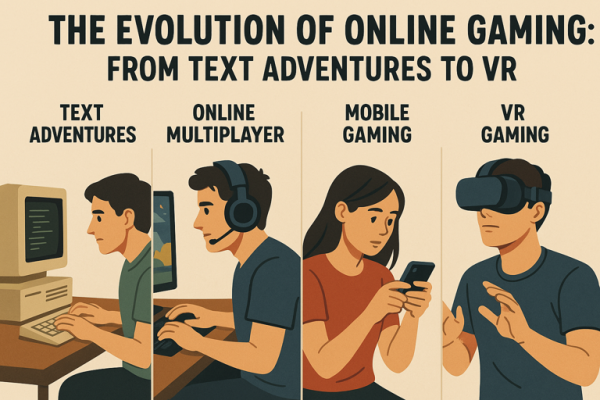The landscape of online gaming has transformed significantly over the past several decades. Initially, games were simple text-based adventures, but they have now evolved into immersive virtual reality (VR) experiences. This transformation reflects technological advancements, changing player expectations, and the deep integration of gaming into our social and cultural lives. Let’s take a look at the journey of online gaming and what the future might hold.
The Early Days: Text Adventures and Basic Networks
The Birth of Online Gaming (1970s-1980s)
Online gaming had modest beginnings in the 1970s with text-based multiplayer games known as MUDs (Multi-User Dungeons). These games, played on early computer networks, allowed players to engage in virtual worlds using text commands. MUD1, created in 1978, is often considered the first online multiplayer game. It involved exploring fantasy worlds, solving puzzles, and role-playing, all through descriptive text.
Technology: These games used early ARPANET and local network connections.
Experience: The gameplay relied heavily on imagination and storytelling due to the absence of graphics.
The Rise of Bulletin Board Systems (BBSs)
In the 1980s, bulletin board systems hosted simple online games like Trade Wars. Players connected through dial-up modems to compete or collaborate in strategy-based scenarios. Although limited, these games set the stage for more advanced online gaming.
The Graphical Revolution: The 1990s
The Emergence of Massively Multiplayer Online Games (MMOGs)
The 1990s were a turning point with the introduction of graphical interfaces. Games like Ultima Online (1997) and EverQuest (1999) introduced richly detailed worlds where thousands of players could interact simultaneously. These games popularized the term MMORPG (Massively Multiplayer Online Role-Playing Game).
Key Features:
- Persistent worlds that continued to evolve even when players were offline.
- Customizable avatars and player-driven economies.
- Social systems such as guilds and alliances.
The Impact of the Internet
With faster internet connections, games supported larger player bases and more dynamic content. Games like Quake (1996) introduced multiplayer first-person shooters (FPS), paving the way for competitive online gaming.
The Early 2000s: Online Gaming Becomes Mainstream
The Golden Age of MMORPGs
The early 2000s saw a boom in MMORPGs, with World of Warcraft (2004) becoming a cultural phenomenon. Millions of players collaborated to explore vast worlds, complete quests, and battle epic bosses.
Why It Worked: Accessibility, rich storytelling, and strong social features made MMORPGs extremely popular.
The Rise of Competitive Gaming
Games like Counter-Strike (2000) and Halo 2 (2004) established online competitive gaming, laying the foundation for the modern esports industry. Players could now compete globally, leading to the creation of online leaderboards and tournaments.
The Mobile and Social Gaming Boom: 2010s
Mobile Gaming Goes Online
Smartphones revolutionized online gaming by making it accessible to anyone with a mobile device. Games like Clash of Clans and PUBG Mobile brought complex online gameplay to handheld devices, while platforms like the App Store and Google Play made distribution easy.
Social Gaming
Social media platforms integrated gaming, with titles like FarmVille and Words with Friends allowing players to compete and collaborate with friends. These games blurred the lines between casual and online gaming.
Virtual Reality and the Present Day
The Emergence of VR Gaming
Virtual reality has elevated online gaming to new heights, offering immersive experiences that were once the stuff of science fiction. Platforms like Oculus VR, HTC Vive, and PlayStation VR now host multiplayer VR games, such as VRChat and Beat Saber, allowing players to interact in fully realized 3D environments. Cross-Platform and Cloud Gaming
In today’s gaming world, the platform you play on is becoming less important. Titles such as Fortnite and Minecraft allow players on computers, consoles, and smartphones to join the same game without any issues. Services like Google Stadia and Xbox Cloud Gaming bypass the need for costly equipment by streaming high-quality games straight to various devices.
The Future of Online Gaming
Metaverse Integration
Gaming is poised to be a key element in the growth of the metaverse, linking virtual realms for play, work, and social interactions.
Artificial Intelligence
AI will enhance NPCs (non-player characters), offering more engaging and tailored gaming experiences.
Haptic Feedback and Advanced VR
Improved touch-based technologies will make virtual interactions seem more lifelike.
Decentralized Gaming
Blockchain and NFTs have the potential to transform in-game economies, providing players with actual ownership of digital items.
Conclusion
The journey of online gaming highlights the rapid technological progress and the increasing cultural significance of gaming. You will find good games on this site https://1winua.com.ua/. From simple text-based games to today’s immersive VR environments, online gaming continues to expand the limits of what can be achieved. The future looks promising, with the lines between virtual and real worlds becoming even more blurred. Whether you enjoy gaming casually or competitively, the future of online gaming promises to be just as thrilling as its rich history.

